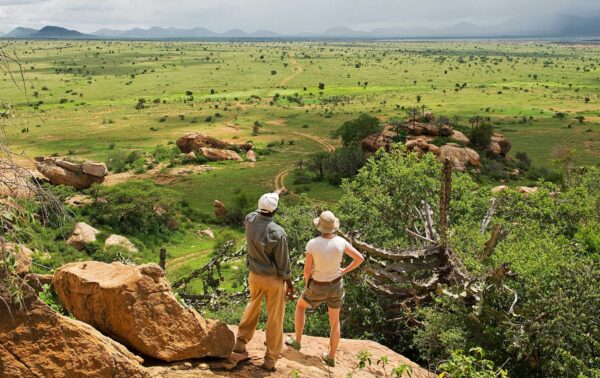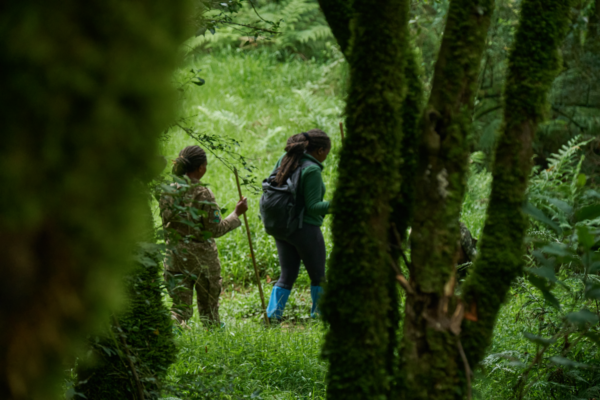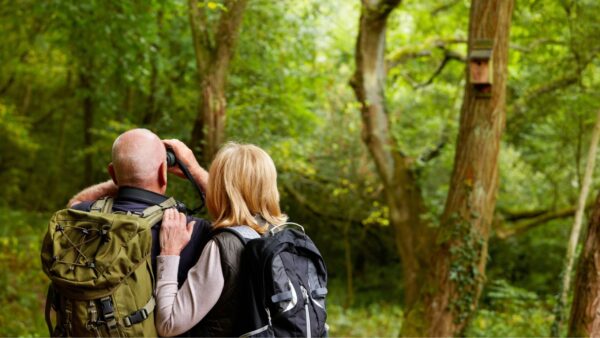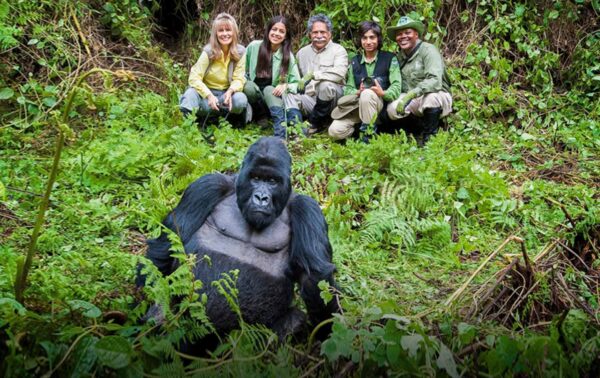
What Should I Wear on a Walking Safari in Uganda?
November 17, 2025Is Chimpanzee Tracking Suitable for Children?
November 18, 2025What Safety Measures Are Taken During Chimpanzee Tracking?
When planning Uganda Chimpanzee Safaris, a critical question on many travelers’ minds is: “What safety measures are taken during chimpanzee tracking?” Chimpanzees are among our closest relatives, exhibiting intelligence, strength, and complex social behaviors that make observing them in the wild an unforgettable experience. However, their powerful physical abilities, unpredictable behavior, and forested habitats necessitate careful safety protocols. Understanding these measures enhances the overall Uganda Wildlife Safari experience while ensuring that tourists can appreciate the adventure without compromising personal safety or wildlife welfare.
Introduction – What Safety Measures Are Taken During Chimpanzee Tracking?
Uganda is globally renowned for its primate-focused safaris, including Uganda Gorilla Trekking Safaris and Uganda Chimpanzee Safaris. Sites such as Kibale Forest National Park, Budongo Forest, and Kyambura Gorge provide prime habitats for chimpanzees, but also feature dense vegetation and challenging terrains. Therefore, Renai Safaris prioritizes safety to balance thrill and protection. From trained guides to clear rules and emergency protocols, every aspect of a chimpanzee tracking safari is carefully regulated to meet international safety standards. Travelers asking “What safety measures are taken during chimpanzee tracking?” gain insights not only into personal precautions but also into responsible tourism practices that protect both visitors and wildlife.
Additionally, understanding safety measures allows tourists to mentally prepare for the trek. The unpredictability of chimpanzee behavior, combined with the forest environment, makes safety awareness essential. Renai Safaris ensures that each guest receives comprehensive briefings, protective equipment recommendations, and guidance on how to observe chimpanzees responsibly. By asking this question before the safari, travelers demonstrate curiosity, preparedness, and a commitment to ethical wildlife experiences—qualities that make Uganda Best Safaris truly rewarding.
Understanding the Risks – Why Are Safety Measures Important?
A natural follow-up question is: “Why are safety measures important during chimpanzee tracking?” Chimpanzees, while fascinating and intelligent, are strong animals capable of sudden aggression if they feel threatened. Their habitats are often remote, with thick undergrowth and uneven trails that present risks of slips, falls, or encounters with other wildlife. Furthermore, human-to-wildlife disease transmission is a concern; close proximity can endanger both tourists and chimpanzees.
Renai Safaris addresses these challenges by implementing multiple layers of protection. First, professional guides are trained in chimpanzee behavior, forest navigation, and first aid. They provide step-by-step instructions on how to maintain a safe distance, avoid eye contact that may be interpreted as threatening, and move calmly within the chimpanzees’ territory. Tourists are briefed on the importance of wearing neutral-colored clothing, minimizing noise, and refraining from sudden movements to avoid startling the animals.
By asking “What safety measures are taken during chimpanzee tracking?”, visitors gain awareness of the delicate balance between observing wildlife closely and maintaining safety. These protocols are part of Uganda Best Safaris because they ensure that the trekking experience is not only thrilling but also secure. Moreover, safety measures extend beyond individual well-being, highlighting Renai Safaris’ commitment to conservation and ethical tourism practices that protect Uganda’s iconic wildlife for future generations.
Professional Guides and Tracking Protocols
When tourists inquire, “What safety measures are taken during chimpanzee tracking?”, one of the primary responses focuses on the role of professional guides. Experienced trackers are the backbone of Uganda Chimpanzee Safaris. They possess intimate knowledge of chimpanzee behavior, vocalizations, and territory ranges, allowing them to predict movements and avoid potential risks.
Guides ensure that trekking groups maintain proper spacing, often advising a minimum distance of seven meters between humans and chimpanzees. This distance reduces the risk of aggressive interactions while limiting the spread of airborne diseases, which can be fatal to chimpanzees. Guides also monitor environmental hazards, such as unstable terrain, low-hanging branches, or slippery surfaces near water sources, ensuring tourists move safely through the forest.
Moreover, Renai Safaris provides structured group sizes, typically limited to six to eight visitors per trek, as recommended by Uganda Wildlife Authority. Small groups reduce noise, minimize forest disturbance, and make it easier for guides to manage safety. When tourists ask “What safety measures are taken during chimpanzee tracking?”, the answer highlights the combination of professional expertise, disciplined group management, and adherence to international best practices. This ensures that Uganda Safaris remain both exhilarating and secure, giving visitors peace of mind while witnessing these extraordinary primates.
Health Precautions and Disease Prevention
A critical dimension of safety measures during chimpanzee tracking involves health precautions. Many travelers ask: “What safety measures are taken during chimpanzee tracking?” with a focus on disease prevention. Chimpanzees share over 98% of human DNA, making them highly susceptible to human illnesses such as respiratory infections, flu, and tuberculosis. To protect both primates and tourists, strict health protocols are enforced during Uganda Chimpanzee Safaris.
Visitors are screened for signs of illness prior to entering tracking zones. Anyone showing symptoms such as coughing, sneezing, or fever may be advised to postpone the trek. Additionally, wearing face masks during the trek is often required to prevent airborne transmission of diseases. Hand sanitization before and after trekking is mandatory, especially when interacting with shared equipment or resting at designated observation points. Renai Safaris educates tourists about the importance of these measures, explaining that responsible behavior safeguards chimpanzee populations and contributes to long-term conservation efforts.
These health precautions are complemented by vaccination recommendations, including yellow fever, tetanus, and malaria prophylaxis. By addressing these questions early, visitors understand that Uganda Wildlife Safaris are not only about adventure but also about protecting one of the world’s most endangered species. Combining these safety measures with other activities, such as Uganda Gorilla Trekking Safaris or Uganda Birding Safaris, ensures a holistic and responsible safari experience.
Gear and Equipment for Safe Chimpanzee Tracking
Another essential aspect to answer the question “What safety measures are taken during chimpanzee tracking?” involves proper gear and equipment. Renai Safaris recommends specific items to ensure comfort, protection, and preparedness during the trek. Sturdy hiking boots with good traction are crucial for navigating muddy or uneven forest floors. Long-sleeved shirts and trousers protect against insect bites, scratches from vegetation, and sun exposure during Uganda Chimpanzee Safaris.
Visitors are advised to carry walking sticks for stability, especially on steep or slippery trails. Binoculars and cameras with zoom lenses allow safe observation without approaching too closely. Rain gear and waterproof bags help protect equipment during sudden tropical showers, while hydration packs ensure tourists remain energized throughout long treks. In some regions, gloves may be recommended to avoid direct contact with potentially rough surfaces or thorny vegetation.
By asking “What safety measures are taken during chimpanzee tracking?”, travelers learn that careful preparation enhances both safety and enjoyment. Renai Safaris emphasizes that well-equipped tourists are less prone to injuries, can maintain proper distance from chimpanzees, and are better able to appreciate Uganda Best Safaris in comfort and security. Additionally, proper gear enables travelers to combine chimpanzee tracking with other activities such as Uganda Birding Safaris or cultural visits, expanding the scope of the safari without compromising safety.
Emergency Response and Contingency Planning
A vital but often overlooked component of chimpanzee tracking safety is emergency preparedness. When visitors ask “What safety measures are taken during chimpanzee tracking?”, Renai Safaris highlights the presence of contingency plans to handle unexpected situations. Each trekking team carries first aid kits and communication devices to contact park authorities if needed. Guides are trained in first aid, basic rescue techniques, and forest navigation, ensuring rapid response to injuries, wildlife encounters, or sudden health issues.
Emergency protocols also include evacuation routes, predetermined meeting points, and coordination with nearby lodges or ranger stations. In remote areas like Kibale Forest, these measures are critical because access to medical facilities may take time. Tourists are briefed on what to do in case of accidents, including remaining calm, following guide instructions, and minimizing movement that could trigger panic or aggressive behavior from wildlife.
These protocols reflect Renai Safaris’ commitment to excellence in Uganda Safaris. By integrating emergency planning with routine safety measures, travelers gain reassurance that their Uganda Chimpanzee Safaris are not only exciting but also carefully managed. Furthermore, such preparedness allows for combining experiences, like Uganda Gorilla Trekking Safaris or Uganda Birding Safaris, without compromising personal safety.
Combining Safety with Conservation Ethics
Finally, understanding “What safety measures are taken during chimpanzee tracking?” underscores the link between visitor safety and wildlife conservation. Maintaining a safe distance, following guide instructions, and adhering to health protocols prevents stress or harm to chimpanzees. This ensures that Uganda Chimpanzee Safaris remain sustainable, preserving populations for future generations.
Renai Safaris encourages tourists to view safety not only as personal protection but also as ethical responsibility. Safe and responsible behavior aligns with Uganda Best Safaris principles, where visitors gain unforgettable wildlife experiences while actively supporting conservation. The integration of safety measures, ecological awareness, and cultural experiences—such as visiting local communities or participating in Uganda Cultural Safaris—creates a balanced itinerary that highlights Uganda’s diversity and promotes long-term sustainability.
By prioritizing both human and animal safety, Renai Safaris demonstrates expertise, authority, and trustworthiness in the Africa tourism industry. Asking “What safety measures are taken during chimpanzee tracking?” therefore opens the door to understanding the interconnected nature of adventure, ethics, and conservation. Tourists leave with not only memories but also an appreciation for responsible safari practices that protect Uganda’s wildlife treasures.
Conclusion – What Safety Measures Are Taken During Chimpanzee Tracking?
In conclusion, the question “What safety measures are taken during chimpanzee tracking?” is central to planning a responsible and enjoyable Uganda Chimpanzee Safari. From professional guides and strict group protocols to health precautions, specialized gear, emergency planning, and conservation ethics, Renai Safaris ensures that every aspect of the safari prioritizes safety without diminishing the thrill of wildlife observation.
Chimpanzees move unpredictably, sometimes alone and sometimes in groups, making careful safety measures essential. Combining chimpanzee tracking with Uganda Gorilla Trekking Safaris, Uganda Birding Safaris, and Uganda Cultural Safaris provides visitors with a holistic, immersive experience while maintaining personal and wildlife safety. By understanding these protocols, travelers gain confidence, insight, and appreciation for Uganda’s rich biodiversity.
Renai Safaris’ approach exemplifies the principles of experience, expertise, authority, and trustworthiness, establishing a model for Africa tourism. Safety measures are not just regulations; they are a gateway to deeper understanding, conservation awareness, and ethical travel. Uganda Best Safaris are therefore defined not only by sightings but also by the secure, responsible, and enriching experiences that leave a lasting impact on travelers and wildlife alike.




